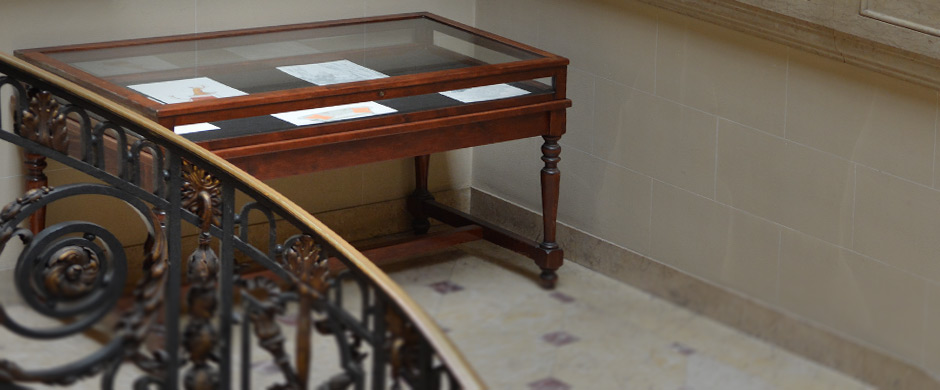 | On Display
| On Display

Display Cases in the Great Hall: Exhibition Archive
PERGAMON ALTERATION
15 May to 17 July 2016
Paintings by Piers Secunda
 Lucius Ampelius described the Pergamon Altar in his Liber Memorialis as one of the wonders of the world, in the only known ancient reference to the greatest surviving monument of Hellenistic sculpture. Although Pergamon first became an important cultural center in the 3rd century B.C.E., the Altar was built from 166-156 B.C.E., to honor Zeus and the Olympian gods and celebrate Attalid dynasty victories by Eumenes II. His successor Attalus III died without male heirs, and the city was ceded to the Roman Empire. Centuries later, as a result of conflicts between Christians and Muslims in the 7th century C.E., the city was dismembered to provide stone for defensive walls, and later abandoned. Ottoman authorities permitted excavations of the site by Prussian engineer Carl Humann in the 19th century, and the removal of the Altar to Berlin. Italian artisans were employed in the early 20th century to reproduce the marble reliefs for study purposes in small format plasters. Depicting a battle of the Gigantomachy, one of these reliefs provides the basis for a series of new paintings by Piers Secunda.
Lucius Ampelius described the Pergamon Altar in his Liber Memorialis as one of the wonders of the world, in the only known ancient reference to the greatest surviving monument of Hellenistic sculpture. Although Pergamon first became an important cultural center in the 3rd century B.C.E., the Altar was built from 166-156 B.C.E., to honor Zeus and the Olympian gods and celebrate Attalid dynasty victories by Eumenes II. His successor Attalus III died without male heirs, and the city was ceded to the Roman Empire. Centuries later, as a result of conflicts between Christians and Muslims in the 7th century C.E., the city was dismembered to provide stone for defensive walls, and later abandoned. Ottoman authorities permitted excavations of the site by Prussian engineer Carl Humann in the 19th century, and the removal of the Altar to Berlin. Italian artisans were employed in the early 20th century to reproduce the marble reliefs for study purposes in small format plasters. Depicting a battle of the Gigantomachy, one of these reliefs provides the basis for a series of new paintings by Piers Secunda.
Secunda sculpts with paint, often recording crimes against humanity. After taking casts of bullet holes in Iraqi Kurdistan from villages liberated from ISIS by the Peshmerga (Kurdish military forces), in 2015 he began a series of works incorporating these casts. The relief used here depicts the essential conflict of the Gigantomachy, where Zeus hurled thunderbolts against Porphyrion, the leader of the Giants. Secunda’s series of paintings presents the Gigantomachy in increasing states of destruction, where the final panel is reduced to rubble by the inclusion of cast ISIS bullet holes.
The Pergamon Altar relief paintings incorporate ISIS bullet holes to document the effects of calculated violence, and the frailty and vulnerability of our collective heritage, even when carefully restored, or protected within museums in the world’s cultural capitals. Secunda offers witness to unspeakable acts by relating forensic evidence through these paintings, elucidating the unthinkable.
Cases One and Two: ISIS Bullet Hole Painting (Zeus), 2016
Industrial floor paint, cast into four panels, each 18 x 32 x 6 inches (dimensions variable)
All paintings courtesy of 532 Gallery Thomas Jaeckel
Curated by Lisa A. Banner
News
Piers Secunda's display cases exhibition gets reviewed in Artnet news.
Contact the Institute
Building Hours
Contact Information
If you wish to receive information on our upcoming events, please subscribe to our mailing list.



